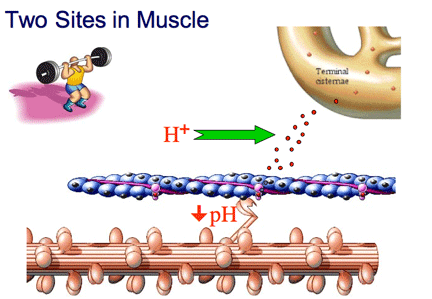| Neuromuscular Junction: With neuromuscular junction there is a breakdown of ACh in getting to the motor end plate, thus the action potential does not reach the motor end plate. Therefore, the muscle contraction will not be able to continue. |
|
Two sites in muscle: At one site, the H+ ions (from the hydrolysis of ATP) interfere with calcium ions from binding to troponin. The interference PREVENTS the configuration shift of tropomyosin to reveal the active bindings sites.
In the second site, the increase in acidosis (from the H+ ion accumulation) will denature (i.e., breakdown or unfold) the enzyme ATPase. This inhibits the splitting of ATP to ADP and Pi and energy. Remember, the H+ accumulation is coming from the hydrolysis of ATP during the exercise bout. The H+ comes from the water molecule (H2O). |
|
Special Note on Fatigue:
There are actually TWO TYPES of fatigue.CENTRAL fatigue is the signal message from the brain to the neuromuscular junction. PERIPHERAL FATIGUE is the signal messages from the neuromuscuscular junction to muscle and within the muscle. In class, we focus on peripheral fatigue.
|
 |
|
|

